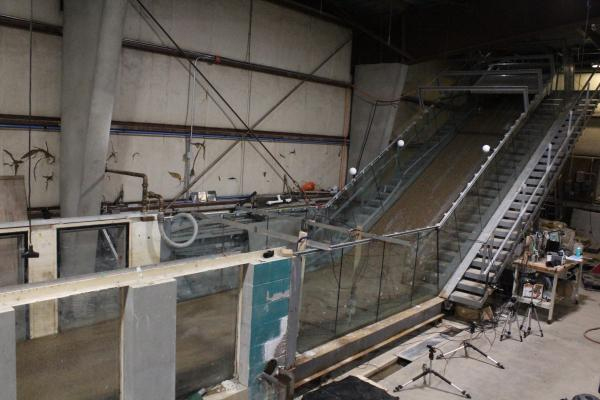Q&A: What factors lead to a mudslide?
November 22, 2021
Share

The picturesque towns and communities in British Columbia’s lower mainland were plunged into chaos this week when parts of Canada’s landscape suddenly changed due to catastrophic flooding, mudslides, and landslides. Queen’s researcher Andy Take, professor and researcher in Geotechnical Engineering in the Department of Civil Engineering, and second-year Master’s student Lisa Tauskela spend their days in the Queen’s Coastal Engineering Lab triggering debris flows, which are commonly called mudslides. Here is a closer look at their research.
What is the difference between a landslide and a mudslide?
What makes a debris flow (mudslide) different from a regular landslide is that liquefaction is occurring in the material. This means the material is saturated with water and due to internal water pressure, the soil grains have lost their friction. Therefore, a previously solid material can now flow like a liquid.
What causes a mudslide?
Excess rain can lead to liquefaction and debris flows as it introduces the requisite water. Debris flows can also be triggered during earthquake, and often occur in mountainous or sloping terrain around the world. Mudslides often travel farther and faster than landslides where liquefaction is not present. This can lead to increased devastation. The United States Geological Survey says debris flows can travel up to and exceeding 55 km/h.
What kind of damage can they cause?
Extremely large debris flows can travel kilometers at high speeds and devastate entire communities. The damage is dependent on the type of landslide that occurs. A 2006 slide in Oso, Washington travelled 100 metres. In 2014, the same slope failed, liquefied the valley floor, and travelled over a kilometre and killed 43 people.
How can you simulate a mudslide in the Coastal Engineering lab?
The objective of the research is to increase the fundamental understanding of liquefaction mechanisms as they affect debris flow mobility. We create landslides of up to 3,000 kg of debris in the Queen’s University flume. This facility consists of a release box located at the crest of an 8-metre-long, 30-degree slope and a 36-metre long horizontal runout zone. (Master's student) Lisa Tauskela varies the water content and volume of the material and captures the landslides with a variety of sensors and cameras. These observations are intended to provide a comprehensive database of landslide behavior to test the ability of newly-developed numerical models. Numerical models that can estimate the likelihood and size of a debris flow are extremely useful for issuing evacuation orders or warnings. Improving the accuracy of these lifesaving models is the subject of research around the world.
How can we prevent them from happening?
We can either stop a debris flow from happening in the first place or we can reduce its impact on nearby people and infrastructure. Debris flows are more likely to occur when excess water is present, whether this is from rainfall, overland flow, or damaged culverts, water pipes etc. Debris flows also occur when the toe (bottom) of a slope is removed, whether this is from erosion or excavation for construction. To prevent debris flows, we should minimize clear-cutting trees, add more vegetation, monitor erosion, and minimize construction near unstable slopes.